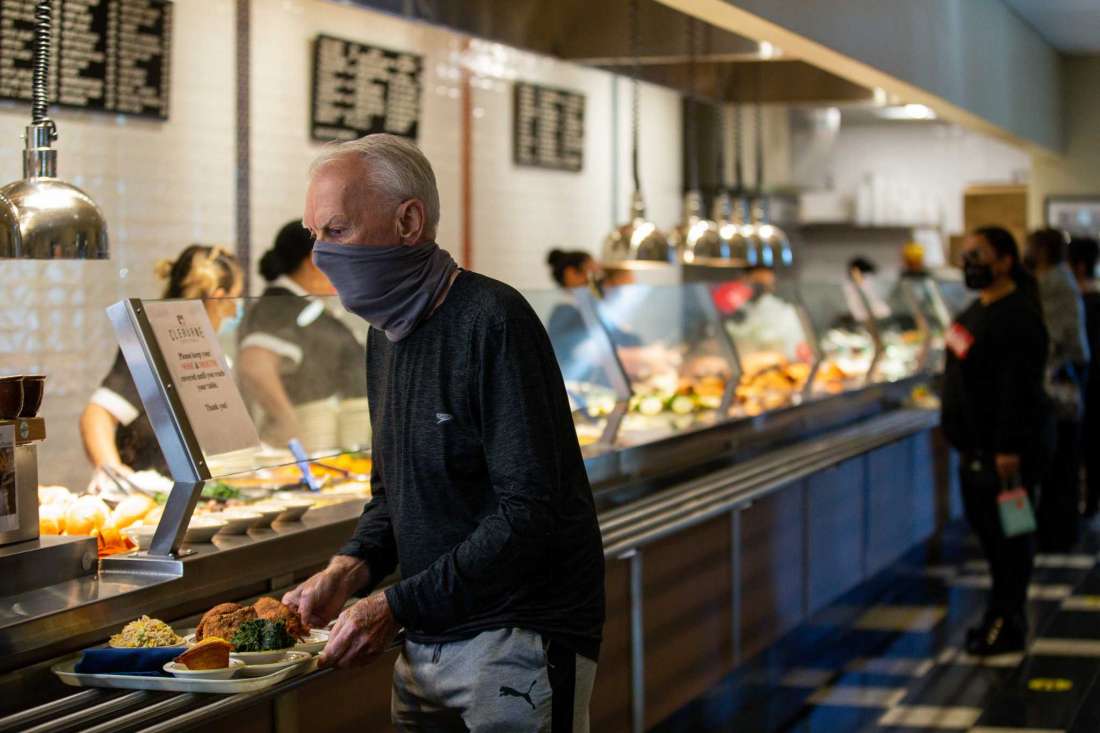
(Cover Photo: Carl Carlock, left, goes through the order line at Cleburne Cafeteria on Thursday, March 18, 2021 in Houston. The Restaurant has seen an increase in business by about 20 percent over the last month.)
The accelerating rollout of vaccines, the lifting of social distancing restrictions, and the sense that the coronavirus pandemic is nearing its end has Houstonians packing restaurants, shops and salons, and leading an upswing in the consumer-driven economy.
Despite warning from public health officials that the pandemic has yet to be brought under control, customers are returning to local businesses in numbers not seen in more than a year. Traffic moving through the city’s major intersections returned to pre-pandemic levels earlier this month, according to data from the Greater Houston Partnership, while reservation at Houston restaurants rose above pre-pandemic levels last week, according to the online reservation service Open Table.
“It’s spring break, it’s cabin fever, it’s vaccinated folks,” said Melissa Stewart, executive director of the Greater Houston Restaurant Association. “We’ll definitely take it.”
At the historic Cleburne Cafeteria on Bissonnet, March sales are up 20 percent from the previous month, said owner George Mickelis. The increase in diners is more than welcome after sales fell by as much as 80 percent last year and nearly sunk the 80-year-old institution.
“We’re just now starting to see some normalcy that we haven’t seen in a long time,” he said, noting sales are just approaching pre-pandemic levels. “We’re seeing an end to a horrific time in history for our country and our small business and just for everybody.”
Around 6 million Texans had received at least one dose of the vaccine as of last week, according to state data, and 3 million were fully vaccinated. For nearly a month, there have been no areas of Texas where COVID-19 hospitalizations make up more than 15 percent of total hospital capacity.
Ariel Gurvey, who lives in the Westbury neighborhood, received her second vaccine at the end of February. Since then, she’s taken special joy in the simple task of going grocery shopping.
“Since I have some health issues, all my shopping was either curbside or delivery or Amazon,” she said. “Now, I feel comfortable in the store.”
For restaurants and retailers, the return of customers like Gurvey is bringing long-awaited relief. An estimated 11,000 restaurants closed across the state since the pandemic started, according to the Texas Restaurant Association, while the region lost more than 200,000 jobs, concentrated in consumer-facing industries, according to the Labor Department.
Medical professionals, however, fear people are letting their guards down too quickly. The nation is still months away from herd immunity and it remains uncertain how effective the vaccines are against new variants of the virus.
In Texas, more than 46,000 died from COVID-19, including nearly 7,800 in Greater Houston.
“Every time I’m driving by and see packed restaurants, packed bars and spring breakers, it gives me pause,” said Dr. Luis Ostrosky, infectious diseases director at UTHealth’s McGovern Medical School. “It’s been a year, and we just need a couple more months.”
Alamo Drafthouse, the dine-in movie theater chain with a location in Katy, isn’t keen on waiting longer. The company, headquartered in Austin, filed for bankruptcy earlier this month after the pandemic hammered its sales, closing its theaters for five months and furloughing 100 employees in Katy alone.
He’s still down about 10 percent compared to March 2019, he said, “but there are a growing amount of people beginning to venture out.”
The increase in activity is spreading across sectors. Interest from prospecitve retail tenants has “increased notably in the past few weeks,” said Kenneth Katz, whose real estate firm owns 30 commercial properties in Houston, including PlazAmericas Mall in Sharpstown. “Things feel very active.”
The Purchasing Manager’s Index, a monthly survey used by supply chains to adjust production to demand, shows the local economy expanding, hitting highest reading in February in nearly two year, said Patrick Jankowski, senior vice president of research at the Greater Houston Partnership. The online hiring platform Snagajob reported a 34 percent increase in job postings over the last month in the Houston area, driven by hiring at warehouses and delivery services.
Posting for restaurant workings climbed 9 percent.
People are returning to work faster in Houston and in Texas, Jankowski said, citing data from Kastle Systems, which sells security services to office buildings. More than one third, or 37 percent of Houstonians, have returned to their desks, compared to about 15 percent of workers in New York and 27 percent in Los Angeles.
“Economic activity is picking up and we’re seeing it across the board,” he said. “It’s not back to pre-pandemic levels, but we’re a lot better off than we were even three months ago.”
The recovery, however, remains uneven. Overall sales at Dish Society, a Houston restaurant chain with five locations, have picked up significantly in recent weeks as more people began dining out, said Aaron Lyons, the restaurant chain’s chief executive. Revenues are running at or near pre-pandemic levels.
The chain’s Heights and Memorial locations are on track for strong comebacks, Lyons said, but the downtown location remains closed. People are starting to return to downtown offices, but at a trickle — not enough to sustain a restaurant, Lyons said.
“I don’t think the traffic is there downtown, yet,” he said. “It’s still really, really dead.”
By Amanda Drane
Houston Chronicle